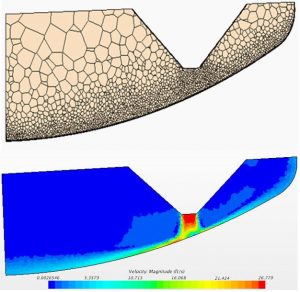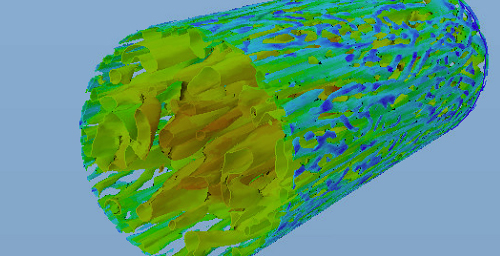Research Areas and Capabilities
Computational Mechanics at ARC uses large scale numerical simulations to investigate and study complex physical phenomena, such as, computational constitutive modeling, turbulent fluid flow and multiphase transport modeling. As an example, we focus on eliminating fidelity issues that exist with the most recent CFD simulations of mixing and delivery of HLW in storage tanks at Hanford sites using accurate modeling in existing CFD platforms.
We also utilize computational mechanics in structural applications to aid in designing mechanical systems and to understand the responses of complex structures to various loading scenarios. Examples include evaluating the designs of robotic systems and simulating non-linear mechanics related to high speed impacts and amour mechanics.

Sectional view of the computational mesh and velocity profile of jet impingement in a scaled down PJM Vessel
Research activities include:
- Development of direct and indirect viscosity modification methods for improving accuracy of scale averaging models (RANS) in flow simulation of non-Newtonian fluids.
- Alpha method, as a dissipation based and direct viscosity adjustment method, was developed at ARC and was successfully tested for laminar, transitional, and turbulent flows.
- A shear correction algorithm, as an indirect method of viscosity adjustment, was developed from simulation of turbulence scales (Quasi-DNS) and was successfully tested at ARC.
- CFD simulations of multiphase and non-Newtonian nature of sediment mobilization (erosion and suspension) caused by rotary jets in waste handling systems.
- Development of stable computational models based on the lattice-Boltzman method for simulation of high velocity jet penetration flows caused by pulse jet mixtures.
- Development of Reduced Order Model (ROM) for reacting gas-solids flows using Proper Orthogonal Decomposition (POD)
- CFD validation of jet impingement characteristics in pulse jet mixing (PJM) process.
Collaborators
- Washington River Protection Solutions
- National Energy Technology Laboratory
Publications and presentations
- Baharanchi A.A., Gokaltun S., Dulikravich G.S., 2015, Performance Improvement of Existing Drag Models in Two-Fluid Modeling of Gas-Solid Flows Using a PR-DNS Based Drag Model, Journal of Powder Technology, Volume 220, pp 63–69
- Baharanchi A.A., Gokaltun S., Edrei, McDaniel D., 2016, Improving the Accuracy of Computational Fluid Dynamics Simulations of Nuclear Waste Mixing using Direct Numerical Simulations, WM2016Conference, March 6-10, 2016, Phoenix Convention Center.
- Baharanchi A.A., Gokaltun S., Dulikravich G.S., 2015, Development Of A Two-Fluid Drag Law For Clustered Particles Using Direct Numerical Simulation And Validation Through Experiment, DOE/NETL Crosscutting Research Review Meetings, July 5-6, 2014, Morgantown WV, USA
- Baharanchi A.A., Gokaltun S., Dulikravich G.S., 2015, Development Of A Two-Fluid Drag Law For Clustered Particles Using Direct Numerical Simulation And Validation Through Experiment, DOE/NETL Crosscutting Research Review Meetings, May 19-23, 2014, Pittsburgh, PA, USA,
- An Experimental Study Using High Speed Imaging Of Clustered Particles For A More Accurate Drag Model In MFIX, Workshop on Multiphase Flow Science, August 6-7, 2013, Morgantown, WV, USA, Baharanchi A.A, Gokaltun S., Manrue N., Dulikravich G.S.,
- Gokaltun, J.Varona, A.Awwad, D.Roelant, Detection of Particle Clustering in Gas-Solid Systems using Shadow-sizing Technique, Powder Technology, v 220, pp. 98 – 103, 2012.
- G. Galdamez, S. Wood, S. Gokaltun, Numerical Simulations of Pulsed-Air Mixing Technology using Multiphase Computational Fluid Dynamics Methods –11301, Proceedings of Waste Management Conference 2011, Feb 27 – Mar 3, 2011, Phoenix, AZ, 2011.
- Ngachin, S. Gokaltun, M. Sukop, Simulation of Rising Bubbles Using the Multiphase Lattice Boltzmann Method – 11656, Proceedings of Waste Management Conference 2011, Feb 27 –Mar 3, 2011, Phoenix, AZ, 2011.
- S.Gokaltun, D. McDaniel, A Lattice Boltzmann Simulation of Gas Bubbles in Multiphase Flows with High Density Ratios – 11304, Proceedings of Waste Management Conference 2011, Feb 27 – Mar 3, 2011, Phoenix, AZ, 2011.
Infrastructure
Instrumentation
- FIU High Performance Computing (HPC) cluster
- STARCCM+, MATLAB, COMSOL
Photos

















